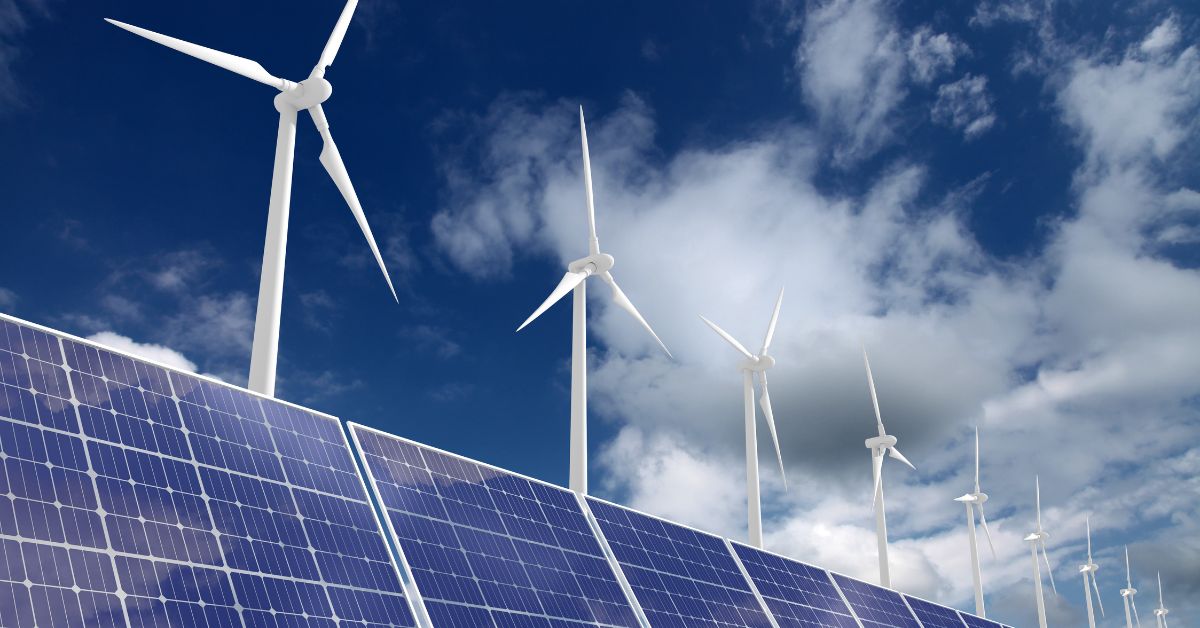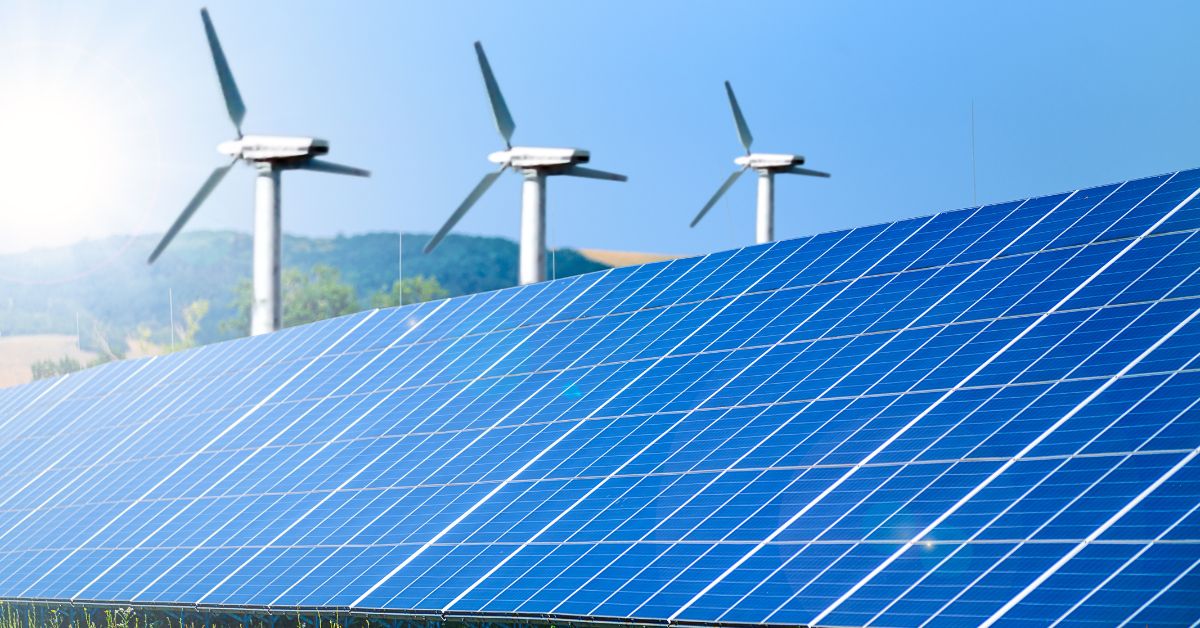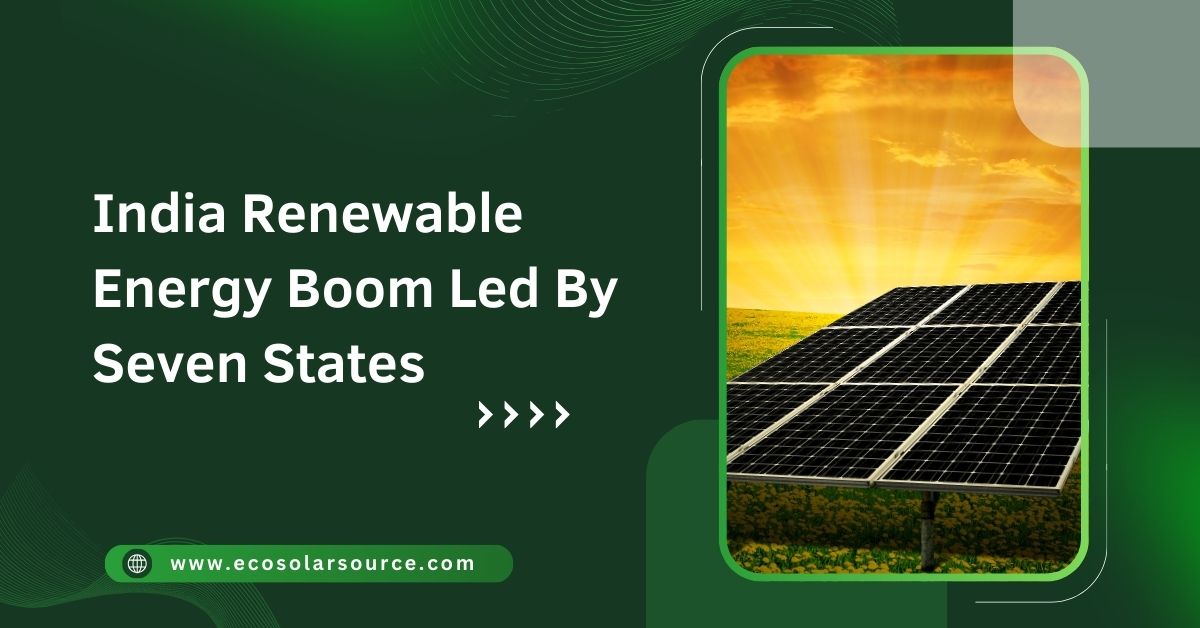India Renewable Energy Boom Led By Seven States
Know the details about India Renewable Energy Boom Led By Seven States, India’s renewable energy sector is undergoing a significant transformation, driven by seven key states: Karnataka, Gujarat, Tamil Nadu, Rajasthan, Andhra Pradesh, Maharashtra, and Madhya Pradesh.
These states are leading the charge in adopting solar, wind, and hybrid energy solutions, collectively contributing over 70% of India’s total renewable capacity. With favorable policies, abundant natural resources, and investment-friendly frameworks, they are attracting both domestic and global players. As India aims to achieve its ambitious target of 500 GW of renewable energy by 2030, these states are pivotal in reducing carbon emissions, enhancing energy security, and fostering sustainable economic growth.
Table of Contents
India Renewable Energy Boom Led By Seven States
India, one of the world’s fastest-growing economies, is experiencing a renewable energy revolution. With increasing demand for electricity, rising pollution levels, and the growing global shift toward sustainable development, the country is rapidly embracing renewable energy sources. A significant share of this energy transition is being driven by seven states that have emerged as leaders in the renewable energy sector. These states—Rajasthan, Gujarat, Tamil Nadu, Karnataka, Maharashtra, Andhra Pradesh, and Madhya Pradesh—are setting benchmarks in solar, wind, and other renewable energy projects. This blog explores the factors behind the renewable energy boom, the role of these states, and the impact on India’s energy landscape.
The Renewable Energy Revolution in India
India is blessed with abundant renewable energy potential, from vast solar energy reserves in the deserts to coastal areas suitable for wind energy. This energy mix presents a unique opportunity for the country to reduce its dependence on fossil fuels, combat climate change, and ensure energy security. As of 2023, India is ranked third globally in terms of renewable energy capacity, only behind China and the United States.

Why is Renewable Energy Important for India?
- Climate Change and Environmental Concerns: India is one of the countries most vulnerable to the impacts of climate change, with extreme weather patterns, rising sea levels, and shifting agricultural patterns. Renewable energy provides a cleaner alternative to fossil fuels, which are major contributors to greenhouse gas emissions.
- Energy Security: India imports a significant portion of its fossil fuel requirements. Renewable energy, particularly solar and wind, offers a way to reduce this dependence, making India more energy-secure.
- Economic Growth: Renewable energy projects create jobs, stimulate technological innovation, and bring investments into local economies. Additionally, the falling cost of renewable energy technologies has made solar and wind power more economically competitive with traditional coal-fired power plants.
- Government Support: India’s government has set ambitious renewable energy targets. Under the National Solar Mission, the country aims to achieve 175 GW of renewable energy capacity by 2022 and 500 GW by 2030. The central government, along with several state governments, has been providing subsidies, tax incentives, and policy support to achieve these goals.
- Global Leadership: India has positioned itself as a leader in the global fight against climate change. Through its participation in international agreements such as the Paris Agreement and its leadership role in the International Solar Alliance (ISA), the country is committed to playing a key role in global energy transitions.
The Seven States Leading India’s Renewable Energy Boom
While every Indian state is contributing to the renewable energy movement in its own way, seven states have emerged as pioneers. Each has made significant strides in renewable energy deployment, with the capacity to drive India’s energy transition.
1. Rajasthan: The Solar Powerhouse
Rajasthan has earned its place as the top state for solar energy generation in India, thanks to its expansive desert areas, high solar radiation, and favorable government policies. The state’s Bhadla Solar Park, one of the largest solar parks in the world, has become a symbol of India’s renewable energy ambitions.
Key Highlights:
- Rajasthan accounts for more than 25% of India’s total installed solar power capacity.
- The state government offers various incentives for solar energy developers, including land allocation and infrastructure support.
- Ongoing efforts to integrate solar power with agriculture (agrivoltaics) provide dual benefits, supporting farmers while generating clean energy.
2. Gujarat: Wind and Solar Synergy
Gujarat, known for its entrepreneurial spirit, has emerged as a major player in both solar and wind energy. The state’s Kutch region, with its high wind speeds, is ideal for wind energy projects. Meanwhile, Gujarat’s solar energy capacity is expanding rapidly, with several large-scale solar parks being developed.
Key Highlights:
- Gujarat was one of the first states to introduce a comprehensive solar policy, leading to the development of projects like the Charanka Solar Park.
- The state’s coastline provides ample opportunities for offshore wind energy development, a frontier that Gujarat is actively exploring.
- Gujarat’s hybrid energy projects (combining solar and wind) are setting new standards for renewable energy integration in India.
3. Tamil Nadu: The Wind Energy Leader
Tamil Nadu has been a long-time leader in wind energy, accounting for nearly a quarter of India’s installed wind energy capacity. The state’s wind energy potential, combined with proactive policies, has made it a renewable energy hub in South India.
Key Highlights:
- Tamil Nadu’s wind energy projects are concentrated in areas like Coimbatore and Thoothukudi, which experience strong, consistent winds.
- The state government has introduced a policy for repowering old wind turbines, boosting energy efficiency and generation capacity.
- Tamil Nadu is also investing in solar energy, with ambitious plans to integrate both solar and wind into its energy mix.
4. Karnataka: A Balanced Renewable Energy Mix
Karnataka has emerged as a leader in renewable energy with a balanced mix of solar, wind, and hydropower. The state is home to the Pavagada Solar Park, one of the largest solar power projects in India.

Key Highlights:
- Karnataka’s renewable energy capacity surpassed 15 GW in 2021, with significant contributions from both solar and wind energy.
- The state government offers numerous incentives for renewable energy developers, including policy support, financial subsidies, and ease of doing business.
- Karnataka is also investing in energy storage technologies, aiming to address the intermittency of renewable energy sources.
5. Maharashtra: Industrial Energy Transition
Maharashtra, India’s most industrialized state, is actively transitioning its energy sector towards renewables. With high electricity demand from industries and cities, the state is focusing on solar and wind energy to reduce its carbon footprint.
Key Highlights:
- Maharashtra’s renewable energy policies focus on both utility-scale projects and rooftop solar installations, particularly in urban areas like Mumbai and Pune.
- The state has been promoting decentralized energy generation, encouraging industries and businesses to adopt solar power.
- Maharashtra’s renewable energy push aligns with its broader climate action goals, which include reducing air pollution and improving energy efficiency.
6. Andhra Pradesh: Solar and Wind Potential
Andhra Pradesh, with its vast coastline and favorable climatic conditions, has significant solar and wind energy potential. The state is actively pursuing large-scale renewable energy projects to meet its growing energy demand.
Key Highlights:
- Andhra Pradesh has ambitious plans to become a renewable energy hub, with a focus on both solar and wind energy projects.
- The state government is exploring offshore wind energy opportunities along its coastline, which could further boost its renewable energy capacity.
- Andhra Pradesh’s proactive renewable energy policies, combined with its geographical advantages, position it as a key player in India’s energy transition.
7. Madhya Pradesh: Scaling Solar Energy
Madhya Pradesh is emerging as a solar energy hub in Central India, with projects like the Rewa Ultra Mega Solar Park making headlines for their scale and cost-effectiveness.
Key Highlights:
- The Rewa Solar Park, one of the largest solar parks in India, has set benchmarks for solar power pricing, attracting investments from around the world.
- Madhya Pradesh’s state government has introduced policies to encourage both large-scale and decentralized solar power generation.
- The state is focusing on expanding its renewable energy infrastructure, particularly in rural areas, to ensure that clean energy reaches every corner of the state.
Factors Driving Renewable Energy Growth in These States
Several factors contribute to the success of these seven states in driving India’s renewable energy boom:

- Natural Resources: Each of these states is rich in renewable energy resources, whether it be Rajasthan’s solar radiation, Tamil Nadu’s wind potential, or Andhra Pradesh’s coastal winds. By leveraging their natural advantages, these states have attracted investments and built robust renewable energy infrastructure.
- Government Policies: Supportive government policies have played a crucial role in the development of renewable energy projects. These states have introduced favorable policies, including feed-in tariffs, subsidies, land allocation, and streamlined regulatory processes, to encourage investments in renewable energy.
- Public-Private Partnerships: Collaboration between the public and private sectors has been key to scaling renewable energy projects. From large corporations to small startups, companies across India are investing in renewable energy, with state governments providing the necessary infrastructure and policy support.
- Technological Innovation: Advancements in technology have made renewable energy more accessible and affordable. Solar panel costs have dropped significantly, while improvements in wind turbine design have boosted efficiency. Energy storage technologies, such as battery storage, are also helping address the intermittency challenges associated with renewable energy sources.
- Global and Domestic Investment: The Indian renewable energy market has attracted significant investments from both domestic and international players. Global financial institutions, foreign governments, and private investors recognize India’s renewable energy potential and are providing the capital needed to develop large-scale projects.
Challenges and the Way Forward
While these seven states are leading India’s renewable energy revolution, several challenges remain:
- Grid Integration: Integrating renewable energy into the existing power grid poses technical challenges, especially in terms of maintaining grid stability and managing energy intermittency.
- Land and Infrastructure: Large-scale renewable energy projects require significant land and infrastructure investments, which can be a hurdle in densely populated or ecologically sensitive areas.
- Policy Consistency: While state governments have introduced favorable policies, inconsistency and delays in policy implementation can hinder the progress of renewable energy projects.
- Energy Storage: Renewable energy sources like solar and wind are intermittent, and energy storage technologies are still in the early stages of development. Scaling up energy storage solutions is essential to ensuring a reliable supply of renewable energy.
FAQs About India Renewable Energy Boom Led By Seven States
Q1. Which seven Indian states are leading the renewable energy boom?
The leading states are Gujarat, Karnataka, Tamil Nadu, Rajasthan, Maharashtra, Andhra Pradesh, and Madhya Pradesh, which have taken significant strides in wind, solar, and other renewable energy projects.
Q2. Why are these seven states dominating the renewable energy sector?
These states benefit from favorable geographical conditions, government policies, abundant natural resources, and large investments in renewable projects, especially in solar and wind energy.
Q3. How much of India’s total renewable energy capacity is contributed by these states?
Together, these seven states contribute over 70% of India’s total renewable energy capacity, helping the country progress toward its renewable energy targets.
Q4. What role does Gujarat play in India’s renewable energy sector?
Gujarat is a leader in solar power production, boasting large-scale solar parks like the one in Dholera, and has also made advancements in wind energy.
Q5. How is Karnataka contributing to renewable energy in India?
Karnataka has been a pioneer in solar energy and leads in installed solar capacity, with projects like the Pavagada Solar Park playing a key role in the state’s energy mix.
Q6. What makes Tamil Nadu a renewable energy hub?
Tamil Nadu is the largest producer of wind energy in India, and it also has significant solar capacity, making it a renewable energy hub in the southern region.
Q7. What renewable energy sources dominate in Rajasthan?
Rajasthan has vast desert areas ideal for large-scale solar farms, making it one of the top solar energy producers in India.
Q8. How has Maharashtra advanced in renewable energy development?
Maharashtra, one of India’s industrial powerhouses, has diversified into wind, solar, and biomass energy to meet its energy demands more sustainably.
Q9. What makes Andhra Pradesh a key player in the renewable energy boom?
Andhra Pradesh has embraced both solar and wind energy, with projects like the Kurnool Ultra Mega Solar Park contributing to its rising renewable energy portfolio.
Q10. What are Madhya Pradesh’s contributions to renewable energy?
Madhya Pradesh is a strong player in solar energy, with notable projects such as the Rewa Solar Park, one of the world’s largest.
Q11. How do state-specific policies impact the renewable energy sector?
Each state has implemented its renewable energy policies, offering incentives, subsidies, and favorable tariffs to attract investors and promote green energy projects.
Q12. What challenges do these states face in scaling renewable energy projects?
Key challenges include land acquisition, grid integration, storage solutions, and regulatory hurdles, which can slow down the development of renewable energy projects.
Q13. What role do public-private partnerships play in the renewable energy boom?
Public-private partnerships have been crucial in attracting investment, sharing risks, and ensuring the execution of large-scale renewable energy projects in these states.
Q14. How does India’s renewable energy growth align with its climate goals?
India aims to achieve 500 GW of renewable energy capacity by 2030, and these seven states are critical in helping the country meet its climate commitments under the Paris Agreement.
Q15. What is the future outlook for renewable energy in these seven states?
With increasing investments, technological advancements, and government support, these seven states are likely to continue leading India’s transition toward a cleaner, greener energy future.
India’s renewable energy boom is being driven by seven key states—Rajasthan, Gujarat, Tamil Nadu, Karnataka, Maharashtra, Andhra Pradesh, and Madhya Pradesh. These states are leveraging their natural resources, supportive government policies, and technological innovations to accelerate the shift toward clean energy. While challenges remain, the progress made by these states offers hope that India can achieve its ambitious renewable energy targets, reduce its carbon footprint, and ensure a sustainable energy future.
As India continues to advance on its renewable energy journey, the leadership of these states will be crucial in shaping the country’s energy landscape and contributing to global efforts to combat climate change.
Click here to learn more about India Renewable Energy Boom Led By Seven States

